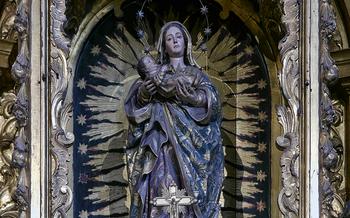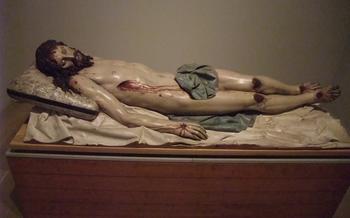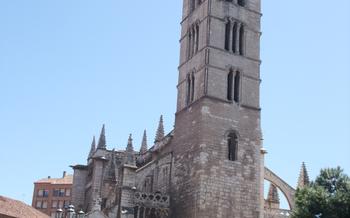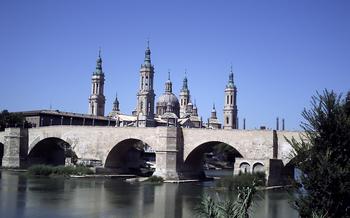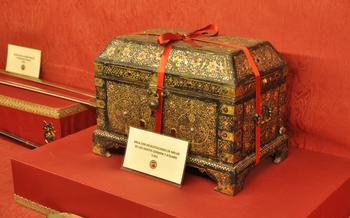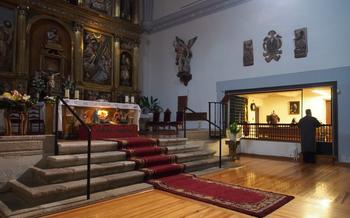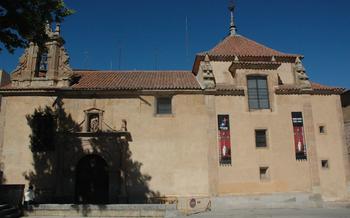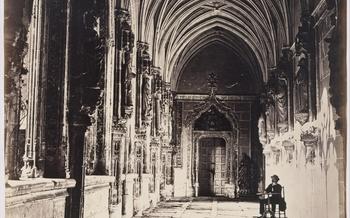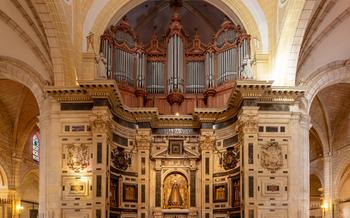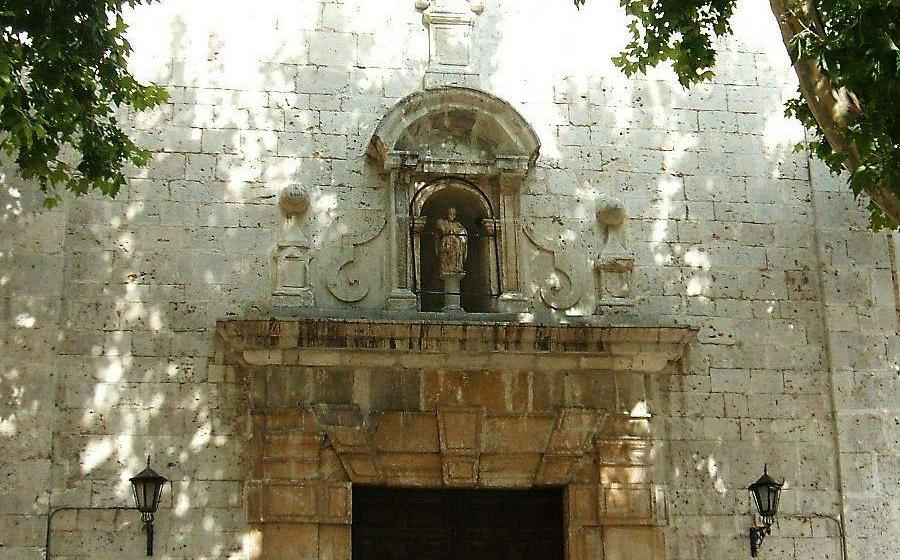
Iglesia de San Nicolás
- Iglesia de San Nicolás: A Monumental Treasure in Valladolid
- Exploring the Gothic Masterpiece
- Unveiling the Church's Interior
- A Journey Through Art and Devotion
- The Altar of San Nicolás
- The Tower of San Nicolás
- The Organ of San Nicolás
- The Cloister of San Nicolás: A Haven of Serenity
- Historical Events and Personalities
- Local Festivals and Celebrations
- Restoration and Preservation Efforts
- Visiting Tips and Practical Information
- Insider Tip: Unveiling a Hidden Gem
Iglesia de San Nicolás: A Monumental Treasure in Valladolid
In the heart San Nicolás, a monumental treasure that invites visitors to immerse themselves in its architectural splendor and religious significance. This Gothic masterpiece, dating back to the 15th century, is a testament to the artistry and devotion that shaped Valladolid's rich cultural heritage.
The Iglesia de San Nicolás holds a prominent place in the city's history, serving as a spiritual sanctuary for generations of faithful Catholics. Dedicated to Saint Nicholas, the patron saint of children and sailors, the church has witnessed countless prayers, celebrations, and moments of profound devotion. Its towering presence, adorned with intricate carvings and magnificent stained glass windows, beckons visitors to step into a realm of architectural wonder and spiritual contemplation.
As you approach the church, its imposing façade, a symphony of Gothic elements, leaves you in awe. The intricate details, from the delicate tracery of the windows to the soaring buttresses, hint at the artistic treasures that await within. The church's grand entrance, framed by an elaborate archway, invites you to embark on a journey through time, where history, art, and faith intertwine.
Exploring the Gothic Masterpiece
The Iglesia de San Nicolás is a stunning testament to the intricate artistry and grandeur of Gothic architecture. Its soaring spires, intricate carvings, and vibrant stained glass windows create a truly awe-inspiring spectacle. The exterior of the church is a masterpiece of Gothic design, with flying buttresses supporting the weight of the walls, allowing for larger windows and a more spacious interior.
The church's façade is adorned with intricate carvings depicting biblical scenes and figures, including the Virgin Mary, Jesus Christ, and various saints. The attention to detail is simply breathtaking, showcasing the skill and artistry of the craftsmen who built this magnificent structure.
Inside the church, the stained glass windows cast a warm and colorful glow, illuminating the grand nave and its impressive height. The windows depict various scenes from the Bible, telling stories of faith, hope, and redemption. The symbolism and hidden meanings embedded in these intricate designs add depth and richness to the overall experience.
The Iglesia de San Nicolás stands as a testament to the enduring legacy of Gothic architecture in Spain. Its stunning beauty and intricate details transport visitors back in time, offering a glimpse into the artistic and spiritual heritage of this fascinating country. Whether you're an architecture enthusiast, a history buff, or simply someone who appreciates beauty, this church is sure to leave you in awe.
Unveiling the Church's Interior
Stepping inside the Iglesia de San Nicolás, visitors are greeted by a breathtaking spectacle of Gothic grandeur. The awe-inspiring nave, with its soaring height and graceful lines, creates a sense of reverence and wonder. The vastness of the interior is accentuated by the intricate web of ribbed vaults overhead, supported by slender columns that seem to reach towards the heavens.
Throughout the church, exquisite altarpieces and sculptures adorn every corner, each a testament to the artistic virtuosity of the era. Masterfully carved figures, imbued with lifelike expressions and intricate details, depict biblical scenes and saints, inviting visitors to contemplate their stories and teachings. The main altarpiece, a stunning masterpiece of Gothic art, is a symphony of carved figures, vibrant colors, and intricate ornamentation, narrating the life and martyrdom of Saint Nicholas, the church's patron saint.
The ceiling paintings, with their rich symbolism and vibrant hues, add to the visual feast. They depict biblical scenes, allegories, and celestial beings, creating a sense of heavenly transcendence. The interplay of light and shadow through the stained glass windows further enhances the ethereal atmosphere, casting a warm glow on the interior and illuminating the intricate details of the artwork.
A Journey Through Art and Devotion
The Iglesia de San Nicolás serves as a canvas for a remarkable collection of religious art, showcasing masterpieces by renowned Spanish artists such as Juan de Juni, whose works adorn the church's interior. These artworks are not merely decorative; they serve as powerful tools for promoting religious devotion, inviting viewers to contemplate the sacred narratives and emotions depicted within.
The church's altarpiece, a stunning masterpiece, captivates visitors with its intricate carvings, vibrant colors, and impressive size. Its scenes depict the life and martyrdom of Saint Nicholas, the church's patron saint, inviting the faithful to reflect on his unwavering faith and the power of divine intervention.
Other notable works of art include sculptures, paintings, and stained glass windows, each contributing to the church's rich visual tapestry. These artworks depict a range of biblical stories and saints, inviting viewers to engage with the divine and find solace and inspiration within the church's sacred space.
The Altar of San Nicolás
The altar of San Nicolás is the centerpiece of the church, a breathtaking masterpiece that commands attention with its intricate carvings, vibrant colors, and impressive size. Dedicated to the church's patron saint, Saint Nicholas, the altarpiece is a testament to the skill and artistry of its creators.
The altarpiece is divided into three sections, each adorned with intricate carvings depicting scenes from the life of Saint Nicholas. The central section features the saint himself, portrayed with a serene expression and surrounded by angels. The side panels depict various miracles attributed to Saint Nicholas, including his rescue of three sailors from a shipwreck and his gift of dowries to three impoverished sisters.
The altarpiece's vibrant colors, achieved through the use of tempera and gold leaf, create a striking contrast against the warm tones of the surrounding stone. The use of gold leaf highlights the importance of the altarpiece and adds to its overall grandeur.
The symbolism of the scenes depicted on the altarpiece is rich and complex. Each panel conveys a message of faith, hope, and charity, emphasizing the virtues that Saint Nicholas embodied. The altarpiece serves as a reminder of the saint's exemplary life and his enduring legacy as a symbol of generosity and compassion.
The altar of San Nicolás is not only a work of art but also a testament to the enduring devotion of the people of Valladolid to their patron saint. It stands as a symbol of the city's rich cultural and religious heritage, attracting visitors from around the world who come to admire its beauty and pay homage to Saint Nicholas.
The Tower of San Nicolás
The Iglesia de San Nicolás boasts an awe-inspiring tower, a majestic landmark that dominates the cityscape of Valladolid. This architectural marvel stands as a testament to the city's rich history and cultural heritage. Constructed in the 13th century, the tower underwent several modifications over the centuries, resulting in a harmonious blend of architectural styles. Its Gothic foundations are complemented by Renaissance and Baroque elements, creating a unique and captivating structure.
Ascending the tower's narrow spiral staircase is a journey through time, offering glimpses of the city's evolving skyline and the surrounding landscapes. The effort is rewarded by the breathtaking panoramic views that unfold from the tower's viewpoint. From this vantage point, visitors can admire the intricate tapestry of Valladolid, with its historic buildings, bustling plazas, and verdant parks. The majestic silhouette of the Cathedral of Valladolid, with its soaring spires and flying buttresses, dominates the horizon, a testament to the city's enduring architectural legacy.
Beyond its aesthetic appeal, the tower of San Nicolás holds historical significance. It served as a watchtower during medieval times, providing a strategic vantage point for spotting approaching enemies or potential threats. The tower's sturdy construction and fortified walls made it an integral part of the city's defense system, protecting its inhabitants from potential invaders.
Today, the tower of San Nicolás stands as a proud symbol of Valladolid's rich heritage, a beacon of resilience and a reminder of the city's architectural prowess. Its enduring presence serves as an inspiration to the people of Valladolid, connecting them to their past while propelling them towards a brighter future.
The Organ of San Nicolás
The Iglesia de San Nicolás houses one of the largest and oldest organs in Spain, a magnificent instrument that has captivated music lovers for centuries. Constructed in the 16th century by the renowned organ builder Bartolomé Tome, the organ boasts an impressive size, with over 2,000 pipes arranged in four divisions. Its intricate carvings and decorative elements showcase the artistry and craftsmanship of its creator.
The organ's unique sound, produced by the combination of its numerous pipes, resonates throughout the church, creating an awe-inspiring atmosphere during religious ceremonies and concerts. The organ's rich tones and melodies have accompanied countless generations of worshippers and visitors, adding to the church's spiritual and cultural significance.
Beyond its musical prowess, the organ of San Nicolás is also a testament to the rich history of organ music in Spain. Organs have played a vital role in Spanish religious and cultural life since the Middle Ages, and the organ of San Nicolás stands as a testament to this enduring tradition.
Visitors to the church are encouraged to attend a concert or service to experience the organ's majestic sound firsthand. The organ's music transports listeners to another era, creating a truly immersive and unforgettable experience.
The Cloister of San Nicolás: A Haven of Serenity
Adjacent to the awe-inspiring Iglesia de San Nicolás, visitors will find a hidden gem that exudes tranquility and architectural elegance: the Cloister of San Nicolás. Step into this serene sanctuary and be enveloped by its peaceful atmosphere, created by the rhythmic arches of Gothic architecture.
The cloister's serene ambiance invites contemplation and prayer. Its Gothic arches, adorned with intricate carvings, form a harmonious ensemble that transports visitors to a realm of spiritual reflection. As you wander through the cloister, the soft echoes of footsteps and whispered prayers create a palpable sense of reverence.
Historically, cloisters like this one served as essential spaces within monasteries and religious institutions. They provided a secluded environment for monks and nuns to engage in contemplation, meditation, and study. In the cloister of San Nicolás, this legacy continues, offering a tranquil refuge for those seeking a moment of respite and spiritual connection.
Don't miss the opportunity to explore this hidden gem during your visit to the Iglesia de San Nicolás. Let the cloister's serene atmosphere wash over you as you immerse yourself in its architectural beauty and historical significance.
Historical Events and Personalities
The Iglesia de San Nicolás has witnessed numerous historical events and been associated with notable figures throughout its existence. In the 16th century, the church hosted the wedding of Philip II, the powerful king of Spain, to his third wife, Elizabeth of Valois. This grand ceremony was attended by many important dignitaries and marked a significant moment in Spanish history.
Over the years, the church has also been visited by several Spanish monarchs, including King Alfonso XIII and Queen Victoria Eugenia, who came to pray and offer their support to the local community. These royal visits underscore the church's importance as a spiritual and cultural landmark in Valladolid.
Beyond royal connections, the church has also been linked to prominent religious figures. Saint John of the Cross, a renowned mystic and poet, spent time at the church during his stay in Valladolid. His presence left a lasting impact on the city's spiritual atmosphere and contributed to the church's significance as a center of devotion.
These historical events and associations with notable individuals have shaped the Iglesia de San Nicolás's identity and made it an integral part of Valladolid's rich tapestry of history and culture.
Local Festivals and Celebrations
The Iglesia de San Nicolás plays a central role in the vibrant tapestry of local festivals and celebrations in Valladolid. During the annual Semana Santa (Holy Week) processions, the church serves as a starting point for solemn processions that wind through the city streets. The air fills with the sounds of somber music, the scent of incense, and the hushed whispers of the faithful as they witness the reenactment of the Passion of Christ.
On the feast day of Saint Nicholas, the church becomes the epicenter of festivities honoring the patron saint. A lively procession, accompanied by traditional music and colorful costumes, parades through the streets, carrying a statue of the saint. The church hosts special masses and prayers, and the square outside is transformed into a bustling fairground with food stalls, games, and entertainment.
Throughout the year, the church also hosts concerts of sacred music, organ recitals, and cultural events that celebrate the rich artistic and spiritual heritage of Valladolid. These events attract both locals and visitors, creating a sense of community and fostering a deep appreciation for the city's historical and cultural treasures.
Restoration and Preservation Efforts
Throughout its existence, the Iglesia de San Nicolás has undergone several restoration and preservation efforts to maintain its architectural integrity and historical significance. In the 19th century, a major renovation project was undertaken to address structural issues and restore the church to its former glory. This involved reinforcing the foundations, repairing the roof, and restoring the intricate carvings on the facade. In the 20th century, further restoration work was carried out to address the effects of time and weather damage. This included cleaning and restoring the stained glass windows, as well as repairing and conserving the interior artwork. The most recent restoration project took place in the early 21st century, focusing on the preservation of the church's cloister and tower. These ongoing efforts are essential in ensuring that the Iglesia de San Nicolás continues to stand as a testament to Valladolid's rich cultural heritage and architectural legacy.
Visiting Tips and Practical Information
To make the most of your visit to the Iglesia de San Nicolás, here are some essential tips to keep in mind:
-
Opening Hours and Admission: The church is generally open to the public from Tuesday to Sunday, with varying hours depending on the season. Admission is free of charge, allowing visitors to explore the church's grandeur at their leisure.
-
Guided Tours: For a deeper understanding of the church's history and significance, guided tours are available in Spanish and English. These tours provide insights into the architectural features, artwork, and religious significance of the church, enhancing the visitor experience.
-
Accessibility: The church is wheelchair accessible, ensuring that visitors with disabilities can comfortably explore its interior. Ramps and elevators are available to facilitate access to different parts of the church, allowing everyone to appreciate its beauty.
-
Dress Code and Behavior: As a place of worship, visitors are expected to dress respectfully and maintain appropriate behavior within the church. Shorts, tank tops, and revealing clothing are discouraged. Silence and reverence are observed during religious services and ceremonies.
-
Photography and Videography: Photography and videography are permitted for personal use, but visitors are requested to be mindful of other visitors and avoid using flash or tripods that may obstruct the view or disturb others. Commercial photography and videography require prior permission from the church authorities.
By following these guidelines, visitors can ensure a respectful and enjoyable experience while exploring the Iglesia de San Nicolás, immersing themselves in its rich history and artistic treasures.
Insider Tip: Unveiling a Hidden Gem
Amidst the many stunning features of the Iglesia de San Nicolás, there lies a hidden gem that often goes unnoticed by visitors. Tucked away in a secluded corner of the church, the Chapel of San Pedro Regalado reveals a breathtaking masterpiece that captures the essence of the Gothic era. Step into this serene sanctuary and gaze upon the intricately carved altarpiece, a testament to the exceptional craftsmanship of its creators. The vibrant colors and lifelike figures seem to transport you back in time, immersing you in the rich history and spirituality of this sacred space. Don't miss the opportunity to discover this hidden gem and marvel at the beauty that lies within.
For an unforgettable experience, plan your visit to the Iglesia de San Nicolás during the golden hour, just before sunset. As the warm sunlight filters through the stained glass windows, the entire church is bathed in a magical glow, casting a mystical aura over its every nook and cranny. It's a sight that will leave you spellbound and create lasting memories of your visit to this architectural masterpiece.
When visiting the church, remember to respect the sacredness of the space and observe proper etiquette. Dress modestly and maintain a respectful demeanor, mindful of the ongoing religious services and the spiritual significance of the church to the local community. Photography is generally permitted, but using flash is discouraged to preserve the artwork's integrity.
To fully appreciate the church's grandeur and history, consider joining a guided tour led by knowledgeable experts. These tours offer fascinating insights into the architectural details, symbolism, and stories behind the artwork, enriching your experience and leaving you with a deeper understanding of this remarkable monument.
As you depart from the Iglesia de San Nicolás, take a moment to reflect on the beauty and spirituality you've encountered. This magnificent edifice stands as a testament to the enduring power of faith, art, and history, inviting you to return and explore its hidden treasures time and again.
